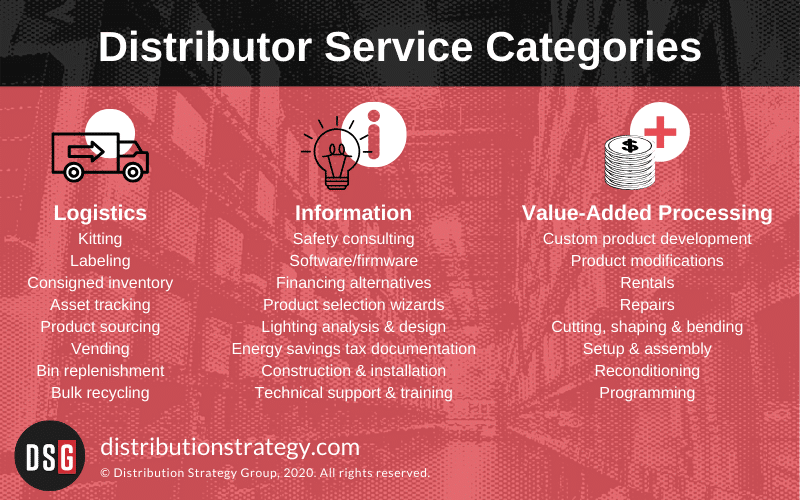Understanding and monetizing value-added services in wholesale distribution is critical to competing today. But many distributors tend to have a limited worldview when it comes to which services they provide.
That is holding them back from getting ahead in a market that’s growing more transactional and where manufacturers can more easily distribute directly to the end-user.
It’s time for distributors to think bigger.
Services can be broken into three categories, logistic, information and value-added processing. The logistic and information services were originally defined in the book “Marketing Channel Strategy: An Omni-Channel Approach”:
Logistic services: These are related to the supply chain. Logistic service attributes include product variety (breadth and depth); convenience/accessibility; immediacy of availability; and lot-size flexibility when it comes to minimum order quantity or product size.
Information services: These require knowledge and expertise on the side of the distributor. These typically happen before the sale. Information service attributes include providing primary information (education, demos, trainings, advice); comparative information (pros and cons, price, promos); product quality assurance; and customization of the transaction (build to order).
Value-added processing: These are connected to information services, as they also require distributor expertise, but are hands-on and usually happen after the sale, including repairs and software setup.

Why logistics are not the future of value-added services
Logistic services like bin replenishment and jobsite delivery are quickly becoming commoditized. Other examples of logistic services include:
- Kitting
- Labeling
- Consigned inventory
- Product sourcing
- Bulk recycling
- Asset tracking
Consider vending as a service. Fastenal’s vending program has long driven its growth and forced competing distributors to offer vending or, simply put, lose accounts. That’s a service Fastenal’s competitors often have to offer customers in response to a request – or else risk the business.
Well-capitalized distributors with greater logistical prowess have rapidly commoditized these types of services, making it more difficult for their competition to stand out. After all, if everyone is offering it, no one is differentiated. These services are still valuable, especially when done well. Certainly, distributors can and should add value for customers in these areas. But they shouldn’t lean on them.
In our annual research into the State of Distributor Marketing, we’ve found that nearly all distributors in our survey rate traditional logistical capabilities such as product selection, availability and speed of delivery as more important to their value propositions despite a decidedly nontraditional shift in the market. This tunnel vision may be keeping distributors from thinking and communicating beyond price and logistics, even as many provide information and value-added processing functions for their customers.
Distributors must offer enough value beyond logistics to keep a customer from going to the competition. Indeed, more than a third of distributors in our 2019 survey said that their survival depends on value-added services.
There’s a whole world of services out there. The opportunity for long-term sustainable competitive advantage for distributors lies not in logistics, but in information services and value-added processing.
Where the real opportunity exists for value-added services
If you want to compete against Amazon Business and other companies that excel at logistics, shift your focus to information services and value-added processing. Information services and value-added processing affect the core function of your customer’s business – or the line function. You want the customer’s costs to fall as you do more work, saving them time, effort and money, and integrating yourself into their operations.
Examples of services that fall into these categories include:
- Hydraulic hose repair
- Calibration
- Fabrication
- Lifting and rigging inspection
- Cutting, shaping, ending
- Training and education
- Safety consulting
- Predictive maintenance
- PCI compliance upgrades
- Energy efficiency consulting
- Tank monitor inspections
There are literally dozens of services that you could offer. So, before you can decide what your service stack looks like, gather data. You probably have opportunities to improve or expand the value-added services that are delivering real value today – or stop offering services customers don’t really want. Without the right data, you might be providing the right service to the wrong person, or spending valuable resources providing a free service to customers that only care about price. Don’t put unnecessary pressure on margins and leave opportunities on the table.
Where to Start with Value-Added Services
Not every distributor is going to move into more services. Many will stick with logistic services. As a result, distributors that win will heed the call to choose the right set of services, communicate them, understand their value and turn them into a profit center. We spoke about best practices in doing all of these in this recent article.
Which services you should consider? When evaluating service options, consider the voice of the customer. Does the customer actually care about that service? (Ask them.) And how competitive and differentiated is that service? In other words, are your direct competitors offering it too?
When looking at the hundreds of potential services in information services and value-added processing, be strategic; this decision is too important to treat like an afterthought.
Watch our recent episode of Wholesale Change to go deeper into value-added services: “The Future of Value-Added Services in Distribution”:
Reach out to Distribution Strategy Group today to evaluate your service offering.
Jonathan Bein, Ph.D. is Managing Partner at Distribution Strategy Group. He’s
developed customer-facing analytics approaches for customer segmentation,
customer lifecycle management, positioning and messaging, pricing and channel strategy for distributors that want to align their sales and marketing resources with how their customers want to shop and buy. If you’re ready to drive real ROI, reach out to Jonathan today at
jbein@distributionstrategy.com.

1 thought on “Want to Differentiate Your Value-Added Services? Go Beyond Logistics”
Services can be broken into three categories, logistic, information, and value-added processing. It helps to increase the business broadly.